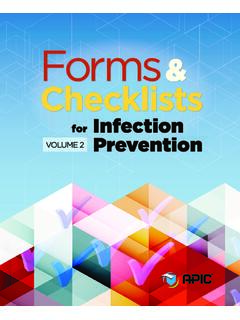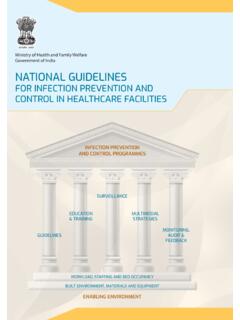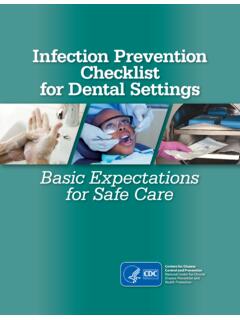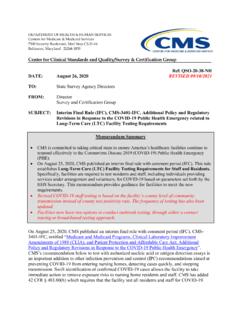Transcription of Guidelines for Infection Control in Dental Health-Care ...
1 Morbidity and Mortality Weekly ReportRecommendations and ReportsDecember 19, 2003 / Vol. 52 / No. RR-17depardepardepardepardepartment of health and human sertment of health and human sertment of health and human sertment of health and human sertment of health and human servicesvicesvicesvicesvicesCenters for disease Control and PreventionCenters for disease Control and PreventionCenters for disease Control and PreventionCenters for disease Control and PreventionCenters for disease Control and PreventionGuidelines for Infection Controlin Dental Health-Care Settings 2003 INSIDE: Continuing Education ExaminationMMWRSUGGESTED CITATIONC enters for disease Control and prevention . Guidelinesfor Infection Control in Dental Health-Care Settings 2003. MMWR 2003;52(No. RR-17):[inclusive pagenumbers].The MMWR series of publications is published by theEpidemiology Program Office, Centers for DiseaseControl and prevention (CDC), Department ofHealth and Human Services, Atlanta, GA for disease Control and PreventionJulie L.
2 Gerberding, , E. Snider, Jr., , (Acting) Deputy Director for Public Health ScienceSusan Y. Chu, , (Acting) Associate Director for ScienceEpidemiology Program OfficeStephen B. Thacker, , of Scientific and Health CommunicationsJohn W. Ward, , MMWR SeriesSuzanne M. Hewitt, Editor, MMWR SeriesC. Kay Smith-Akin, Technical Writer/EditorC. Kay Smith-Akin, W. WeatherwaxProject EditorsBeverly J. HollandLead Visual Information SpecialistMalbea A. LaPeteVisual Information SpecialistKim L. Bright, M. Doan, R. ShaverInformation Technology Specialists* For Continuing Dental Education (CDE), see request additional copies of this report, contact CDC's Divisionof Oral Health by e-mail: telephone: 770-488-6054; or fax: of RelationshipOur subject matter experts wish to disclose they have no financialinterests or other relationships with the manufacture of commercialproducts, providers of commercial services, or commercial report does not include any discussion of the unlabeled use ofcommercial products or products for investigational 2 Previous 3 Selected 4 Review of Science Related to Dental Infection 6 Personnel Health Elements of an 6 Preventing Transmissionof Bloodborne 10 Hand 14 Personal Protective 16 Contact Dermatitis and Latex 19 Sterilization and Disinfection of Patient-Care 20 Environmental Infection 25 Dental Unit Waterlines, Biofilm.
3 And Water 28 Special 30 Dental Handpieces and Other Devices Attachedto Air and 30 Saliva 31 Dental 31 Aseptic Technique for Parenteral 31 Single-Use or Disposable 32 Preprocedural Mouth Rinses .. 32 Oral surgical 32 Handling of Biopsy 33 Handling of Extracted 33 Dental 33 Laser/Electrosurgery Plumes or surgical 34M. disease and Other Prion 36 Program 37 Infection - Control Research 39 Infection - Control Internet 48 Appendix 62 Appendix 65 Appendix 66 Continuing Education Activity*.. CE-1 Vol. 52 / RR-17 Recommendations and Reports1 Guidelines for Infection Controlin Dental Health-Care Settings 2003 Prepared byWilliam G. Kohn, S. Collins, L. Cleveland, A. Harte, J. Eklund, M. Malvitz, of Oral HealthNational center for Chronic disease prevention and Health Promotion, CDC2 United States Air Force Dental Investigation ServiceGreat Lakes, Illinois3 The Forsyth InstituteBoston, MassachusettsSummaryThis report consolidates previous recommendations and adds new ones for Infection Control in Dental settings.
4 Recommendationsare provided regarding 1) educating and protecting Dental Health-Care personnel; 2) preventing transmission of bloodborne patho-gens; 3) hand hygiene; 4) personal protective equipment; 5) contact dermatitis and latex hypersensitivity; 6) sterilization anddisinfection of patient-care items; 7) environmental Infection Control ; 8) Dental unit waterlines, biofilm, and water quality; and9) special considerations ( , Dental handpieces and other devices, radiology, parenteral medications, oral surgical procedures, anddental laboratories). These recommendations were developed in collaboration with and after review by authorities on infectioncontrol from CDC and other public agencies, academia, and private and professional organizations. hand-hygiene products and surgical hand antisepsis; contact dermatitis and latex hypersensitivity; sterilization of unwrapped instruments; Dental water-quality concerns ( , Dental unit waterlinebiofilms; delivery of water of acceptable biological qualityfor patient care; usefulness of flushing waterlines; use ofsterile irrigating solutions for oral surgical procedures;handling of community boil-water advisories); Dental radiology; aseptic technique for parenteral medications; preprocedural mouth rinsing for patients; oral surgical procedures; laser/electrosurgery plumes; tuberculosis (TB); Creutzfeldt-Jakob disease (CJD) and other prion-relateddiseases; Infection - Control program evaluation; and research Guidelines were developed by CDC staff members incollaboration with other authorities on Infection Control .
5 Draftdocuments were reviewed by other federal agencies and profes-sional organizations from the fields of Dental health care, publichealth, and hospital epidemiology and Infection Control . A Fed-eral Register notice elicited public comments that were consid-ered in the decision-making process. Existing Guidelines andpublished research pertinent to Dental Infection - Control prin-IntroductionThis report consolidates recommendations for preventingand controlling infectious diseases and managing personnelhealth and safety concerns related to Infection Control in den-tal settings. This report 1) updates and revises previous CDCrecommendations regarding Infection Control in Dental set-tings (1,2); 2) incorporates relevant Infection - Control measuresfrom other CDC Guidelines ; and 3) discusses concerns notaddressed in previous recommendations for dentistry.
6 Theseupdates and additional topics include the following: application of standard precautions rather than universalprecautions; work restrictions for Health-Care personnel (HCP) infectedwith or occupationally exposed to infectious diseases; management of occupational exposures to bloodbornepathogens, including postexposure prophylaxis (PEP) forwork exposures to hepatitis B virus (HBV), hepatitis Cvirus (HCV); and human immunodeficiency virus (HIV); selection and use of devices with features designed to pre-vent sharps injury;The material in this report originated in the National center for ChronicDisease prevention and Health Promotion, James S. Marks, , , Director; and the Division of Oral Health, William R. Maas, , , 19, 2003ciples and practices were reviewed. Wherever possible, recom-mendations are based on data from well-designed scientific stud-ies.
7 However, only a limited number of studies have characterizedrisk factors and the effectiveness of prevention measures forinfections associated with Dental Health-Care Infection - Control practices routinely used by Health-Care practitioners cannot be rigorously examined for ethical orlogistical reasons. In the absence of scientific evidence for suchpractices, certain recommendations are based on strong theo-retical rationale, suggestive evidence, or opinions of respectedauthorities based on clinical experience, descriptive studies, orcommittee reports. In addition, some recommendations arederived from federal regulations. No recommendations areoffered for practices for which insufficient scientific evidenceor lack of consensus supporting their effectiveness the United States, an estimated 9 million persons work inhealth-care professions, including approximately 168,000 den-tists, 112,000 registered Dental hygienists, 218,000 dentalassistants (3), and 53,000 Dental laboratory technicians (4).
8 In this report, Dental Health-Care personnel (DHCP) refers toall paid and unpaid personnel in the Dental Health-Care settingwho might be occupationally exposed to infectious materials,including body substances and contaminated supplies, equip-ment, environmental surfaces, water, or air. DHCP includedentists, Dental hygienists, Dental assistants, Dental laboratorytechnicians (in-office and commercial), students and trainees,contractual personnel, and other persons not directly involvedin patient care but potentially exposed to infectious agents ( ,administrative, clerical, housekeeping, maintenance, or vol-unteer personnel). Recommendations in this report aredesigned to prevent or reduce potential for disease transmis-sion from patient to DHCP, from DHCP to patient, and frompatient to patient. Although these Guidelines focus mainly onoutpatient, ambulatory Dental Health-Care settings, the recom-mended Infection - Control practices are applicable to all set-tings in which Dental treatment is patients and DHCP can be exposed to pathogenicmicroorganisms including cytomegalovirus (CMV), HBV,HCV, herpes simplex virus types 1 and 2, HIV, Mycobacte-rium tuberculosis, staphylococci, streptococci, and other virusesand bacteria that colonize or infect the oral cavity and respira-tory tract.
9 These organisms can be transmitted in Dental set-tings through 1) direct contact with blood, oral fluids, or otherpatient materials; 2) indirect contact with contaminatedobjects ( , instruments, equipment, or environmental sur-faces); 3) contact of conjunctival, nasal, or oral mucosa withdroplets ( , spatter) containing microorganisms generatedfrom an infected person and propelled a short distance ( ,by coughing, sneezing, or talking); and 4) inhalation of air-borne microorganisms that can remain suspended in the airfor long periods (5). Infection through any of these routes requires that all of thefollowing conditions be present: a pathogenic organism of sufficient virulence and inadequate numbers to cause disease ; a reservoir or source that allows the pathogen to surviveand multiply ( , blood); a mode of transmission from the source to the host; a portal of entry through which the pathogen can enterthe host; and a susceptible host ( , one who is not immune).
10 Occurrence of these events provides the chain of Infection (6).Effective Infection - Control strategies prevent disease transmis-sion by interrupting one or more links in the CDC recommendations regarding Infection con-trol for dentistry focused primarily on the risk of transmissionof bloodborne pathogens among DHCP and patients and useof universal precautions to reduce that risk (1,2,7,8). Univer-sal precautions were based on the concept that all blood andbody fluids that might be contaminated with blood should betreated as infectious because patients with bloodborne infec-tions can be asymptomatic or unaware they are infected (9,10).Preventive practices used to reduce blood exposures, particu-larly percutaneous exposures, include 1) careful handling ofsharp instruments, 2) use of rubber dams to minimize bloodspattering; 3) handwashing; and 4) use of protective barriers( , gloves, masks, protective eyewear, and gowns).















